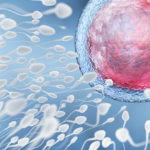About Fertility
How Pregnancy Actually Happens

The egg’s voyage is a miraculous journey. Ovulation is a volcano-like eruption on the ovarian surface of the follicle where the egg is matured. Some women experience this normal monthly event as mid-cycle pain on one side or the other, depending on which ovary ovulation occurs. In this blog, we hope to provide insight into how pregnancy actually happens.
The Role of the Fallopian Tube in Pregnancy
The ovulated egg is caught by the sweeping tentacles of the flowered end of the fallopian tube called the fimbria. The fallopian tube’s capture of the egg is facilitated by its enclosure in a surrounding sticky shell-like structure called the zona pellucida. The egg is then quite literally swallowed by the fallopian tube and propelled in a conveyor-like fashion by the beating hair-like projections called cilia lining the fallopian tube. Finally, the egg reaches the mid-portion of the fallopian tube, called the ampullary region, where it rests and will die within 24 hours unless successfully courted by an amorous suitor (fertilized).
What Happens to Sperm During Conception?
Only a few hundred of the millions of sperm deposited actually reach the egg. The sperm, like hounds to the hunt, are thought to be guided to the egg by her alluring secretions acting like homing beacons. Upon finally reaching the egg by those that could follow directions, the sperm (still as yet a team effort) become hyper-activated, beating their tails in frenzy (like a Golden Retriever with a new toy). This passion provides the mechanical energy necessary for sperm to disperse the cumulous oophorus and bind to the zona pellucida.
At this time, a chemical is released by the attached sperm in a bombarding-like process called the acrosome reaction. Acrosomal enzymes, like barbarians at the gate, barrage the zona pellucida by making small holes like individual battering rams so that one victorious sperm of the hundreds lucky enough to be there out of the millions who tried can now triumphantly swim through and reach the egg surface. Once the egg recognizes that her defensive wall has been breached, she transforms her zona into an impenetrable barrier preventing additional sperm from entering and is thereby left alone to dance with the now only one intrepid intruder.
Fertilization
On the day of fertilization, still, within the comforting confines of the fallopian tube’s ampullary region, the genetic material of the sperm and the genetic material of the egg fuse to form an early embryo called a 2PN for two pronuclei. By the second day following fertilization, the embryo develops into a two to four-cell embryo and continues its journey down the fallopian tube. These embryonic cells continue to divide producing a ball or cluster of cells by the fifth day after fertilization called a blastocyst.
At this blastocyst stage of development, the embryo leaves the fallopian tube and enters into the uterine cavity. Once in the uterine cavity, the blastocyst literally hatches from its zona-like shell. After an additional two days of wandering, seeking a safe and secure place to land, the hatched blastocyst finally burrows into the luxurious uterine wall from which, if all goes right, a baby is born nine months later. And this is how pregnancy actually happens!
Contact Us
If you have more questions on how pregnancy actually happens or are having difficulty getting pregnant, please contact us for an initial consultation. We are here to help.


